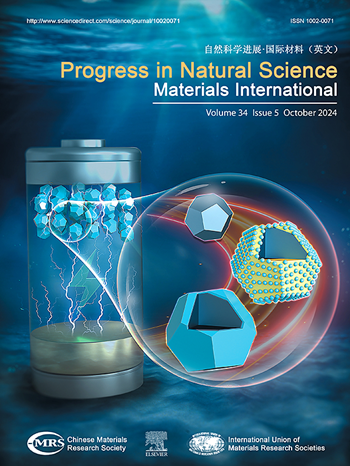Identification of the different phase structures in hafnium oxide ferroelectric thin films by atomic image simulations
IF 7.1
2区 材料科学
Q2 MATERIALS SCIENCE, MULTIDISCIPLINARY
Progress in Natural Science: Materials International
Pub Date : 2025-04-01
DOI:10.1016/j.pnsc.2025.02.005
引用次数: 0
Abstract
Hafnium oxide ferroelectric memory offers non-volatility, low power consumption, fast read-write speed, <1 nm scalability, and CMOS compatibility, making it a promising next-generation nonvolatile memory device. However, because the ferroelectric phase is not thermodynamically stable, hafnium oxide thin film prepared by atomic layer deposition contains several phases with very similar structures. For example, the orthorhombic and tetragonal phases are nearly indistinguishable when the grain size is small using synchrotron radiation X-ray diffraction, challenging its characterization and mechanism study. In this work, the multi-slice algorithm was utilized to simulate atomic scanning transmission electron microscopy images. For the experimental part, aberration-corrected scanning transmission electron microscopy was employed to acquire high-angle annular dark-field images and annular bright-field images. Based on the results, we proposed that when utilizing specific orientation to distinguish various phases, imaging conditions such as spherical aberration coefficient, tilt angle, film thickness, etc., affect the analysis to some extent. This work lays the foundation for understanding hafnium-based ferroelectric phase structure.
用原子图像模拟方法鉴定氧化铪铁电薄膜的不同相结构
氧化铪铁电存储器具有非易失性、低功耗、快速读写速度、1nm可扩展性和CMOS兼容性等优点,是下一代非易失性存储器器件。然而,由于铁电相不具有热力学稳定性,原子层沉积法制备的氧化铪薄膜包含了几个结构非常相似的相。例如,在同步辐射x射线衍射中,当晶粒尺寸较小时,正交相和四方相几乎无法区分,这给其表征和机理研究带来了挑战。在这项工作中,利用多切片算法模拟原子扫描透射电子显微镜图像。实验部分采用像差校正扫描透射电镜获得高角度环形暗场图像和环形明场图像。在此基础上,我们提出在利用比取向识别不同相位时,球差系数、倾斜角度、薄膜厚度等成像条件对分析有一定影响。这项工作为理解含铪铁电相结构奠定了基础。
本文章由计算机程序翻译,如有差异,请以英文原文为准。
求助全文
约1分钟内获得全文
求助全文
来源期刊
CiteScore
8.60
自引率
2.10%
发文量
2812
审稿时长
49 days
期刊介绍:
Progress in Natural Science: Materials International provides scientists and engineers throughout the world with a central vehicle for the exchange and dissemination of basic theoretical studies and applied research of advanced materials. The emphasis is placed on original research, both analytical and experimental, which is of permanent interest to engineers and scientists, covering all aspects of new materials and technologies, such as, energy and environmental materials; advanced structural materials; advanced transportation materials, functional and electronic materials; nano-scale and amorphous materials; health and biological materials; materials modeling and simulation; materials characterization; and so on. The latest research achievements and innovative papers in basic theoretical studies and applied research of material science will be carefully selected and promptly reported. Thus, the aim of this Journal is to serve the global materials science and technology community with the latest research findings.
As a service to readers, an international bibliography of recent publications in advanced materials is published bimonthly.

 求助内容:
求助内容: 应助结果提醒方式:
应助结果提醒方式:


